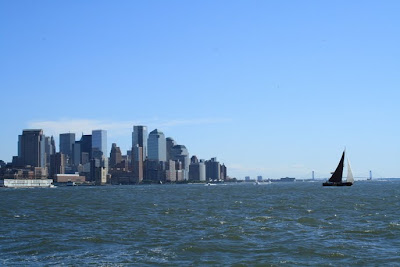
In September 1609, a sailing Dutchman named Henry Hudson happened upon the eponymous Hudson River. It was a beautiful day, all blue skies and warm breezes.

By the time Hudson's crew rolled in, they were cold and mutinous... they'd just tried and failed to forge a route through what is essentially the North Pole. (Sadly, this route is now navigable due to climate change.)

The crew set up camp on an island the local Lenape tribe called Mannahatta, "island of many hills." (The Lenape had obviously never seen San Francisco.)

On a warm day in September, my own crew set sail on the Clearwater, a gorgeous old sailboat with a mast constructed from a single tall tree. The idea for the Clearwater was conceived by folk legend Pete Seeger and built in 1969. Today, it has a vast wooden deck, a kickass educational program, and a slew of passionate interns and volunteers.

The Clearwater composts all of their food waste at the awesome composting operation at Red Hook Community Farm. Who says nonprofits can't network with the best of 'em?

My crew and I arrived at the dock behind the Red Hook Fairway at 09:00. After a group effort to hoist up the sail, we proceeded through the Buttermilk Channel to the Battery Harbor for-- and I'm not kidding-- a boat parade for the prince of the Netherlands.
I imagine the prince in his castle declaring his desire for a full-on flotilla in NYC. "Your wish is my command, sire," his loyal servant would pronounce.
We wondered aloud: what if the prince was 3 years old and had a poopy diaper? Did he wear a crown? Was he single?
The Clearwater got in formation behind old-looking boats with whimsical names like The Peacemaker.

The prince's boat was a ginormous... we thought we spotted him in a pink tie for a fleeting moment, but machine guns (see below) deterred us from hoisting ourselves into the water and throwing ourselves at his feet like teenaged Jonas Brothers fans. Instead, we did the wave. Classy.

We proceeded to sail in incredibly close quarters around the harbor. It was more than evident that the real crew was stressed by the proximity certain unruly boats. Many flotilla vessels had either sailed from Holland or stuck their boats in containers and shipped them to New York. The small ships below are called Flying Dutchmen, which seemed enough to warrant their participation in the Dutch celebration.

It is easy to forget that this crazy city is, at its heart, a maritime wonderland. Until you take to the water, that is. Reality check 101.

The Clearwater aims to illuminate this fact. Getting to experience the city from the water provides the passenger a privileged view of the importance of healthy waterways.

If this isn't a privileged view, I don't know what is.

The Clearwater accepts volunteer educators, apprentices, and crew to join its ranks, and frequently opens itself up for public sails!
*The Supreme Court decided that streams and wetlands are exempt from protection from the Clean Water Act. Sign the petition to advocate for change! Streams and wetlands may not be grandiose as lakes and rivers, but they're just as important for a healthy ecosystem!
















